-
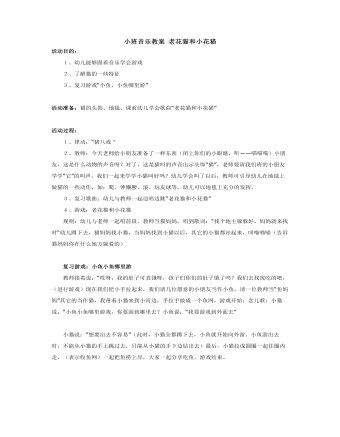
小班音乐教案 老花猫和小花猫
2、了解猫的一些特征 3、复习游戏“小鱼,小鱼哪里游” 活动准备:猫的头饰、地毯、课前幼儿学会歌曲“老花猫和小花猫” 活动过程: 1、律动:“猪八戒" 2、教师:今天老师给小朋友准备了一样东西(闭上你们的小眼睛,听——喵喵喵)小朋友,这是什么动物的声音呀?对了,这是猫叫的声音出示头饰“猫”,老师要请我们班的小朋友学学“它”的叫声,我们一起来学学小猫叫好吗?幼儿学会叫了以后,教师可引导幼儿在地毯上做猫的一些动作,如:爬、伸懒腰、滚、玩皮球等。幼儿可以地毯上充分的发挥。 3、复习歌曲:幼儿与教师一起边唱边跳“老花猫和小花猫”
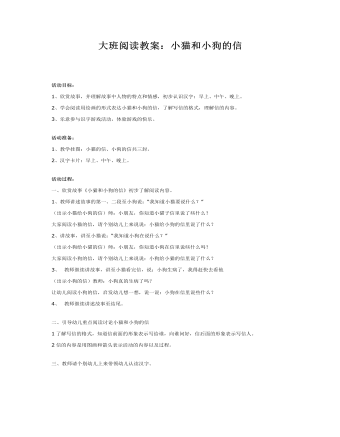
大班阅读教案:小猫和小狗的信
2、学会阅读用绘画的形式表达小猫和小狗的信,了解写信的格式,理解信的内容。 3、乐意参与识字游戏活动,体验游戏的快乐。 活动准备:1、教学挂图:小猫的信、小狗的信共三封。2、汉字卡片:早上、中午、晚上。 活动过程: 一、欣赏故事《小猫和小狗的信》初步了解阅读内容。 1、教师讲述故事的第一、二段至小狗说:“我知道小猫要说什么?” (出示小猫给小狗的信)师:小朋友,你知道小猫子信里说了些什么? 大家阅读小猫的信,请个别幼儿上来说说:小猫给小狗的信里说了什么?
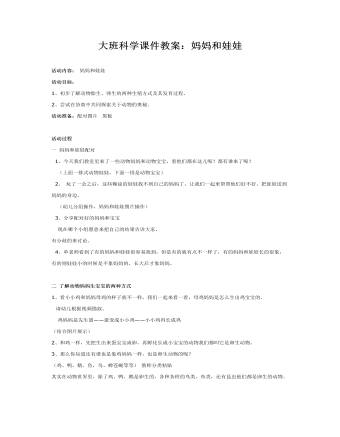
大班科学课件教案:妈妈和娃娃
活动目标:1、初步了解动物胎生、卵生的两种生殖方式及其发育过程。2、尝试在协商中共同探索关于动物的奥秘。活动准备:配对图片 黑板 活动过程一妈妈和娃娃配对 1、今天我们教室里来了一些动物妈妈和动物宝宝,看他们都在这儿呢?都有谁来了呢? (上面一排式动物娃娃,下面一排是动物宝宝) 2、玩了一会之后,这些糊涂的娃娃找不到自己的妈妈了,让我们一起来帮帮他们好不好,把娃娃送到妈妈的身边。 (幼儿分组操作,妈妈和娃娃图片操作) 3、分享配对好的妈妈和宝宝 现在哪个小组愿意来把自己的结果告诉大家。有分歧的来讨论。 4、单老师看到了有的妈妈和娃娃很容易找到,但是有的就有点不一样了,有的妈妈和娃娃长的很象,有的则娃娃小的时候是不象妈妈的,长大后才象妈妈。
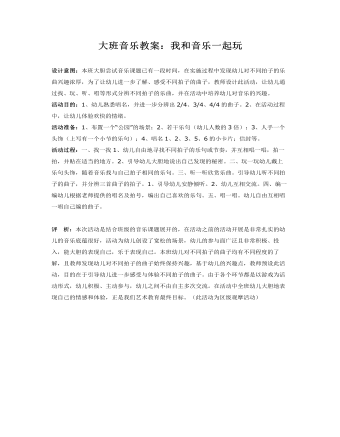
大班音乐教案:我和音乐一起玩
活动准备:1、布置一个“公园”的场景;2、若干乐句(幼儿人数的3倍);3、人手一个头饰(上写有一个小节的乐句);4、唱名1、2、3、5、6的小卡片;信封等。活动过程:一、找一找1、幼儿自由地寻找不同拍子的乐句或节奏,并互相唱一唱,拍一拍,并贴在适当的地方。2、引导幼儿大胆地说出自己发现的秘密。二、玩一玩幼儿戴上乐句头饰,随着音乐找与自己拍子相同的乐句。三、听一听欣赏乐曲。引导幼儿听不同拍子的曲子,并分辨三首曲子的拍子。1、引导幼儿安静倾听。2、幼儿互相交流。四、编一编幼儿根据老师提供的唱名及拍号,编出自己喜欢的乐句。五、唱一唱。幼儿自由互相唱一唱自己编的曲子。
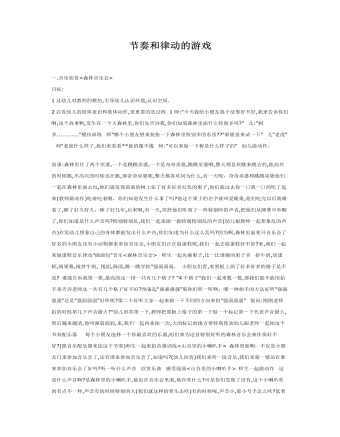
大班游戏教案:节奏和律动的游戏
2启发幼儿的肢体意识和肢体动作,更重要的是过程 1师:"今天我给小朋友将个故事好不好,我来告诉你们啊,这个故事啊,发生在一个大森林里,你们先告诉我,你们知道森林里面什么特别多吗?" 儿:"树多............"模仿训练 师"哪个小朋友想来装扮一下森林里特别多的东西??"谁愿意来试一下" 儿"老虎" 师"老虎什么样子,我们来看看**做的像不像 师:"可以来做一下树是什么样子的" 幼儿做动作。故事:森林里住了两个巫婆,一个是跳跳巫婆,一个是奇奇巫婆,跳跳巫婆啊,整天都喜欢跳来跳去的,他高兴的时候跳,不高兴的时候也在跳,那奇奇巫婆呢,整天都喜欢问为什么,有一天呢,奇奇巫婆和跳跳巫婆他们一起在森林里面去玩,他们就发现前面的树上张了好多好多红色的果子,他们就过去你一口我一口的吃了起来(教师做动作)吃着吃着啊,你们知道发生什么事了吗?他这个果子的名字就叫爱睡果,他们吃完以后就睡着了,睡了好久好久,睡了好几年,后来啊,有一天,突然他们听到了一阵特别吵的声音,把他们从睡梦中吵醒了,你们知道是什么声音吗?特别特别乱,我们一起来做一做特别特别乱的声音(幼儿根教师一起想象乱的声音)启发幼儿想象自己的身体都能发出什么声音,你们知道为什么这么乱吗?因为啊,森林里面要开音乐会了好多的小朋友还有小动物都来参加音乐会,小朋友们正在做蛋糕呢,我们一起去做蛋糕好不好?来,我们一起来做蛋糕音乐律动"做面包"音乐<森林音乐会> 师生一起先摘果子,比一比谁摘的果子多 挤牛奶,切蛋糕,刷果酱,搅拌牛奶, 搅面,跺面,跳一跳学拍"强弱弱弱.
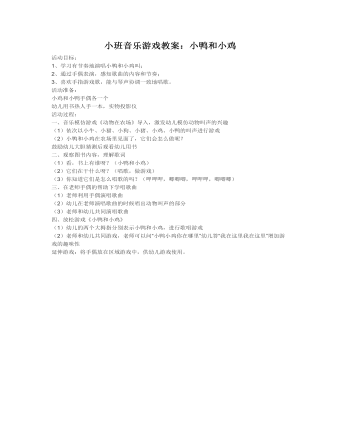
小班音乐游戏教案:小鸭和小鸡
2、通过手偶表演,感知歌曲的内容和节奏; 3、喜欢手指游戏歌,能与琴声协调一致地唱歌。 活动准备: 小鸡和小鸭手偶各一个 幼儿用书热人手一本,实物投影仪 活动过程: 一、音乐模仿游戏《动物在农场》导入,激发幼儿模仿动物叫声的兴趣 (1)依次以小牛、小猫、小狗、小猪、小鸡、小鸭的叫声进行游戏 (2)小鸭和小鸡在农场里见面了,它们会怎么做呢? 鼓励幼儿大胆猜测后观看幼儿用书 二、观察图书内容,理解歌词 (1)看,书上有谁呀?(小鸭和小鸡) (2)它们在干什么呀?(唱歌,做游戏) (3)你知道它们是怎么唱歌的吗?(呷呷呷,唧唧唧,呷呷呷,唧唧唧)
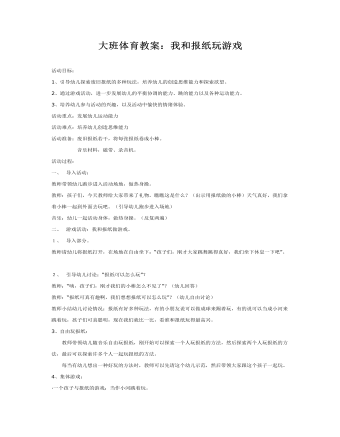
大班体育教案:我和报纸玩游戏
2、通过游戏活动,进一步发展幼儿的平衡协调的能力、跳的能力以及各种运动能力。3、培养幼儿参与活动的兴趣,以及活动中愉快的情绪体验。 活动重点:发展幼儿运动能力 活动难点:培养幼儿创造思维能力活动准备:废旧报纸若干,将每张报纸卷成小棒。 音乐材料,磁带、录音机。 活动过程: 一、 导入活动: 教师带领幼儿跑步进入活动场地,做热身操。 教师:孩子们,今天教师给大家带来了礼物。瞧瞧这是什么?(出示用报纸做的小棒)天气真好,我们拿着小棒一起到外面去玩吧。(引导幼儿跑步进入场地) 音乐:幼儿一起活动身体,做热身操。(反复两遍) 二、 游戏活动:我和报纸做游戏。 1、 导入部分。 教师请幼儿将报纸打开,在场地在自由坐下:“孩子们,刚才大家跳舞跳得真好,我们坐下休息一下吧”。 2、 引导幼儿讨论:“报纸可以怎么玩”? 教师:“咦,孩子们,刚才我们的小棒怎么不见了”?(幼儿回答) 教师:“报纸可真有趣啊,我们想想报纸可以怎么玩”?(幼儿自由讨论) 教师小结幼儿讨论情况:报纸有好多种玩法,有的小朋友说可以做成球来踢着玩,有的说可以当成小河来跳着玩,孩子们可真聪明,现在我们就比一比,看谁和报纸玩得最高兴。
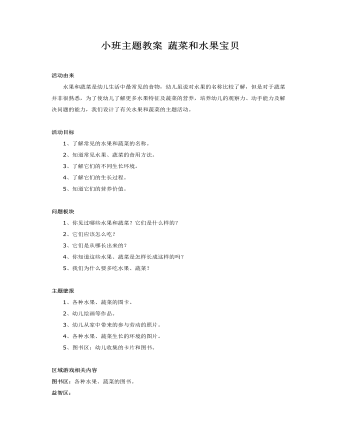
小班主题教案 蔬菜和水果宝贝
活动目标1、了解常见的水果和蔬菜的名称。2、知道常见水果、蔬菜的食用方法。3、了解它们的不同生长环境。4、了解它们的生长过程。5、知道它们的营养价值。 问题板块1、你见过哪些水果和蔬菜?它们是什么样的?2、它们应该怎么吃?3、它们是从哪长出来的?4、你知道这些水果、蔬菜是怎样长成这样的吗?5、我们为什么要多吃水果、蔬菜?
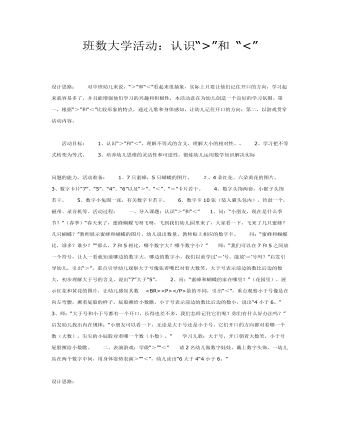
大班数大学活动:认识”和 “课件教案
活动目标: 1、认识“>”和“<”,理解不等式的含义,理解大小的相对性。。 2、学习把不等式转变为等式。 3、培养幼儿思维的灵活性和可逆性,锻炼幼儿运用数学知识解决实际 问题的能力。活动准备: 1、7只蜜蜂,5只蝴蝶的图片。 2、4朵红花、六朵黄花的图片。 3、数字卡片“7”、“5”、“4”、“6”以及“>”、“<”、“=”卡片若干。 4、数字头饰两套,小猴子头饰若干。 5、数字小兔图一张,有关数字卡若干。 6、数字卡10张(装入猫头包内),铃鼓一个,磁带、录音机等。活动过程: 一、导入课题:认识“>”和“<” 1、问:“小朋友,现在是什么季节?”(春季)“春天来了,蜜蜂蝴蝶飞呀飞呀,飞到我们幼儿园里来了,大家看一下,飞来了几只蜜蜂?几只蝴蝶?”教师展示蜜蜂和蝴蝶的图片,幼儿说出数量,教师贴上相应的数字卡。 问:“蜜蜂和蝴蝶比,谁多?谁少?”“那么,7和5相比,哪个数字大?哪个数字小?” 师:“我们可以在7和5之间放一个符号,让人一看就知道哪边的数字大,哪边的数字小。我们以前学过‘=’号,能放‘=’号吗?”启发引导幼儿,引出“>”,重点引导幼儿观察大于号像张着嘴巴对着大数笑,大于号表示前边的数比后边的数大,初步理解大于号的含义,说出“7”大于“5”。
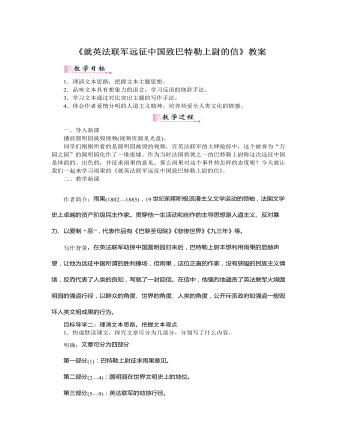
部编版语文九年级上册《就英法联军远征中国致巴特勒上尉的信》教案
3.作者是如何表达出自己的观点的?明确:作者首先以瑰丽的语言盛赞圆明园在人类文明中的地位,其后,又以比喻及反讽的修辞,将英法联军劫掠圆明园的罪行揭露而出,两者形成鲜明的对比,从而引出谴责英法联军远征中国行为的观点。目标导学三:了解作者心中的圆明园及英法联军的强盗行径1.作者是如何描述他心目中的圆明园的?明确:圆明园是幻想的某种规模巨大的典范,一座言语无法形容的建筑,某种恍若月宫的建筑。作者用大理石,玉石,青铜,瓷器,雪松,宝石,绸缎,神殿,后宫,城楼,神像,异兽,琉璃,珐琅,黄金,脂粉,一座座花园,一方方水池,一眼眼喷泉,成群的天鹅、朱鹭和孔雀等无数华贵的象征,铺就了一张华贵的想象画面,构成他心中的圆明园。正如他所说“总而言之,请你假设人类幻想的某种令人眼花缭乱的洞府,其外观是神庙,是宫殿,那就是这座园林”。
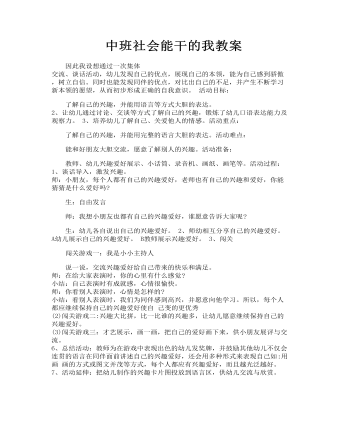
能干的小手中班教案中班社会能干的我教案
1、谈话导入,激发兴趣。 师:小朋友,每个人都有自己的兴趣爱好,老师也有自己的兴趣和爱好,你能猜猜是什么爱好吗? 生:自由发言 师:我想小朋友也都有自己的兴趣爱好,谁愿意告诉大家呢? 生:幼儿各自说出自己的兴趣爱好。 2、师幼相互分享自己的兴趣爱好。A幼儿展示自己的兴趣爱好。 B教师展示兴趣爱好。 3、闯关 闯关游戏一:我是小小主持人

初中历史与社会人教版九年级下册《地球一小时 活动》教材教案
地球一小时(Earth Hour)是世界自然基金会(WWF)应对全球气候变化所提出的一项倡议,希望家庭及商界用户关上不必要的电灯及耗电产品一小时。来表明他们对应对气候变化行动的支持。过量二氧化碳排放导致的气候变化目前已经极大地威胁到地球上人类的生存。公众只有通过改变全球民众对于二氧化碳排放的态度,才能减轻这一威胁对世界造成的影响。地球一小时在3月的最后一个星期六20:30~21:30期间熄灯。活动由来:“地球1小时”也称“关灯一小时”,是世界自然基金会在2007年向全球发出的一项倡议:呼吁个人、社区、企业和政府在每年三月最后一个星期六20:30~21:30期间熄灯1小时,以此来激发人们对保护地球的责任感,以及对气候变化等环境问题的思考,表明对全球共同抵御气候变暖行动的支持。这是一项全球性的活动,世界自然基金会于2007年首次在悉尼倡导之后,以惊人的速度席卷全球,大家都来参加这个活动。[1] “地球1小时”活动首次于2007年3月31日在澳大利亚的悉尼展开,一下子吸引了超过220万悉尼家庭和企业参加;随后,该活动以惊人的速度迅速席卷全球。在2008年,WWF(中国)对外联络处透露,全球已经有超过80个国家、大约1000座城市加入活动。2013年,包括悉尼歌剧院、帝国大厦、东京塔、迪拜塔、白金汉宫在内的各国标志性建筑也在当地时间晚八点半熄灯一小时。[2] ,其中包括巴勒斯坦、法属圭亚那、加拉帕戈斯群岛、卢旺达、圣赫勒那岛、苏里南、突尼斯等首次参与“地球一小时”的国家和地区。在中国,北京鸟巢、水立方、世贸天阶等标志性建筑同时熄灯,同一时段,从上海东方明珠到武汉黄鹤楼,从台北101到香港天际100观景台,中国各地多个标志性建筑均熄灯一小时,全国共有127个城市加入“地球一小时”活动。
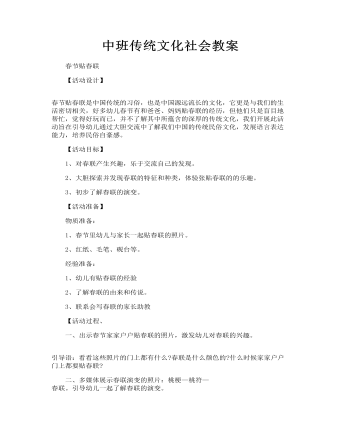
中班传统文化社会教案幼儿园传统文化教案
1、对春联产生兴趣,乐于交流自己的发现。 2、大胆探索并发现春联的特征和种类,体验张贴春联的的乐趣。 3、初步了解春联的演变。 【活动准备】 物质准备: 1、春节里幼儿与家长一起贴春联的照片。 2、红纸、毛笔、砚台等。 经验准备: 1、幼儿有贴春联的经验 2、了解春联的由来和传说。 3、联系会写春联的家长助教
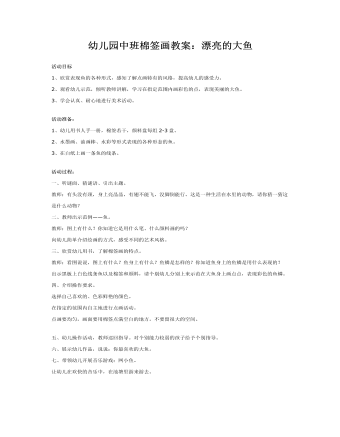
中班棉签画教案:漂亮的大鱼课件教案
2、观看幼儿示范,倾听教师讲解,学习在指定范围内画彩色的点,表现美丽的大鱼。 3、学会认真、耐心地进行美术活动。 活动准备: 1、幼儿用书人手一册,棉签若干,颜料盘每组2-3盘。 2、水墨画、油画棒、水彩等形式表现的各种形态的鱼。 3、在白纸上画一条鱼的线条。 活动过程:一、听谜面、猜谜语、引出主题。 教师:有头没有颈,身上亮晶晶,有翅不能飞,没脚倒能行。这是一种生活在水里的动物,请你猜一猜这是什么动物?
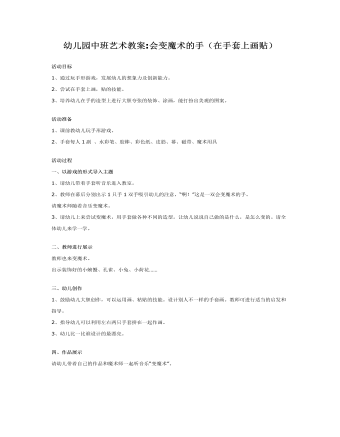
中班艺术教案:会变魔术的手课件教案
2、尝试在手套上画,贴的技能。 3、培养幼儿在手的造型上进行大胆夸张的装饰、涂画,能打扮出美观的图案。 活动准备 1、课前教幼儿玩手形游戏。 2、手套每人1副、水彩笔、胶棒、彩色纸、皮筋、幕、磁带、魔术用具活动过程一、以游戏的形式导入主题 1、请幼儿带着手套听音乐进入教室。 2、教师在幕后分别出示1只手1双手吸引幼儿的注意,“啊!”这是一双会变魔术的手。 请魔术师随着音乐变魔术。 3、请幼儿上来尝试变魔术,用手套做各种不同的造型。让幼儿说说自己做的是什么,是怎么变的。请全体幼儿来学一学。

人教版新目标初中英语八年级上册I’m going to be a basketball player教案3篇
教学目标1.知识目标:(1)学习What are you going to be when you grow up?/How are you going to do that?句式。(2)学会用英语描述有关职业的表达法。2.能力目标:(1)能够谈论为实现理想所做出的打算和安排。(2)能够谈论未来自己与他人理想的职业及原因。(3)能用英语描述课余时间的活动安排,最终具备表达综合信息的能力。3.情感目标:新学期到来之际,让他们在学习、体育、饮食、特长、读书等方面制定计划,教育学生合理安排自己的课外生活,思考自己的理想职业及适合自己的职业。教学重点、难点本单元的重点为“be going to”表将来,want to be, what,where, when,how引导的特殊疑问句。难点是语言目标的实现。教材分析本单元以I am going to be a basketball player为话题,共设计了三部分的内容:一、Section A该部分有4个模块。第一模块围绕Do you think these jobs are interesting?这一话题展开思维(1a)、听力(1b)、口语(1c)训练;
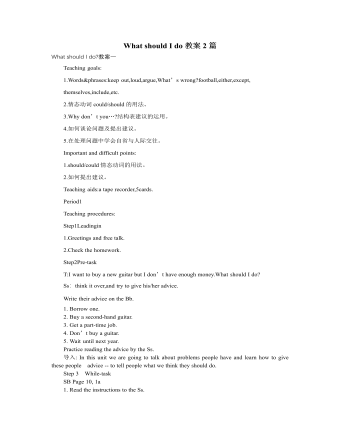
人教版新目标初中英语八年级下册What should I do教案2篇
说明:在帮Li Lei提建议的同时,教育学生如何学好英语。第三课时教学目标1. 语言目标:a) 词汇: Original, in style, haircut, the same as.b) 语言结构:My friend wears the same clothes and has the same haircut as I do.2. 能力目标:大多数学生能够谈论自己喜欢哪种服装,提高查找信息的能力。3. 情感目标:学会如何与朋友相处,要有自己对时尚的看法。教学重点掌握一些重要词汇。教学难点学会谈论问题,并能提出书面建议。◆教学突破首先针对Erin的问题,提出个人的建议,模仿2c部分的对话展开双人交际Pair-work;听老师诵读3a部分的信件,并找出LEFT OUT的问题所在;学生完成3b部分的内容,给Left Out提出书面的建议;学以口头形式提出自己目前存在的某个问题,讲给大家听,让同学们给自己提出一个建议,并作笔录;学生两、三个人分成一组,随意性地进行口语交际,谈论P14的第4部分的某个问题,相互交换意见。
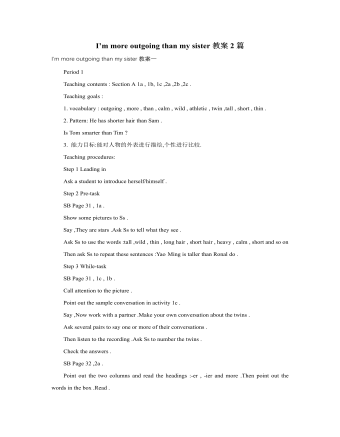
人教版新目标初中英语八年级上册I’m more outgoing than my sister教案2篇
1 交通工具的比较此活动为小组活动。学生通过讨论找出到达某一城市可乘坐的各种交通工具,并选择最佳出行方式。Teacher:We’re going to Shanghai. How many ways can we use to get there? Yes, there are four ways: by bus, by plane, by train, by ship. Please discuss how you are going to get there.操作建议:(1)学生以小组为单位展开活动,谈论本组所选择的交通工具。(2)各组选代表向全班汇报,阐述本组所选择的交通工具的利和弊。完成任务所需要的语言结构:We can go there by ship. It’s more comfortable and cheaper than any other transportation.We can go there by bus. It’s cheaper but it takes longer time.2 哪个城市更合适?此活动具有挑战性。假设中国要举行2014年世界杯足球赛,分别从历史,人文,天气等方面对各城市(北京,大连,上海,昆明)进行比较,选择最佳举办城市。T: Imagine China is holding the 2014 FIFA World Cup. Which city do you think is the best for the World Cup, Beijing, Dalian, Shanghai or Kunming? Let’s work in groups. If you choose Beijing, please join the Team Red. If you chose Dalian, please join the Team White. If you choose Shanghai, please join the Team Blue. If you choose Kunming, please join the Team Green. Please show us its advantages. Then let’s see which team will win.
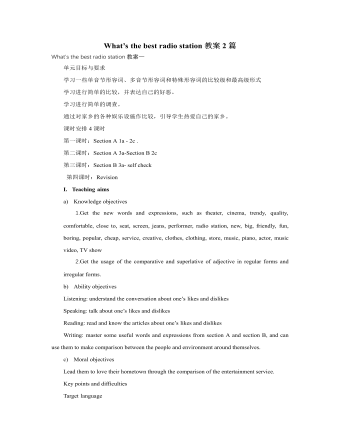
人教版新目标初中英语八年级上册What’s the best radio station教案2篇
教学重点和难点:运用所掌握的语言描述,比较不同地点的特点。在练习中学习掌握英语比较级和最高级的用法。课前准备分配小组,每组五至六人。通过上网或翻阅报刊杂志等方法,确定旅游线路,做出基本的旅游计划。教学设计:本节课流程图 学法指导:1.由于这是一堂新课,在教学中应注意面向全体,发挥学生的主体性,引导学生积极参与,激发学生的求知欲和学习积极性,指导学生积极思维,主动获取知识,养成良好的学习方法。逐步学会独立解决问题。总之要尽可能调动学生的非智力因素促进智力因素的发展。教法选择:1.电化教学法2.课堂讨论法3.任务型教学法采用这些方法的目的是为了充分调动学生的学习积极性,使学生变被动学习为主动学习。通过电脑形象的演示,加强印象,提高兴趣,突破难点,提高教学效率,进而增大教学的容量和信息量。充分体现教师为主导,学生为主体的教学原则。

人教版新目标初中英语八年级下册Why don’t you get her a scarf教案
教师带领学生复习有关描述宠物的词汇,采用教师提问学生回答的方进行。如:T:What animals do you think would be good pets?What animals do you think would be bad pets?What do you think are good animals for a six-year-old child?然后学生进行 pairwork 练习。Task two: 师生互动,学习探究 1、播放3a部分的录音,引导学生一边听录音,一边跟读。2、通过听录音学生回答以下问题:Why do you think pot-bellied pigs are popular?What are the advantages and disadvantages of keeping such a pet?教师对学生的回答进行及时点评。3.学习范文,学习重点短语,为下步的模仿写作提供语言素材。T :1. )Have you ever kept a pig as a pet?Do you like pigs? St.:No.…Why don’t you like to keep a pig? St: No.They’re too dirty and lazy(Do you know in some foreign countries like Hollyland, Australia,pigs are the most popular pet.there’s a kind of pig.(图)it has an interesting name? it ‘s called a pot-bellied pig.) Now,let’s learn an article about this kind of interesting pet.2.)play the tapeSt.:Listen and repeat3.)show some Qs on computer(本子St.: read silently,then answerthe Qs(本子)4.)Ask ss. Close book and retell this passage.(what is a pot-bellied pig? Is it a good or bad pet? ) St.: retell it to each other“A pot –bellied pig is a popular pet now…”5.read the article together.St.:.practice reading